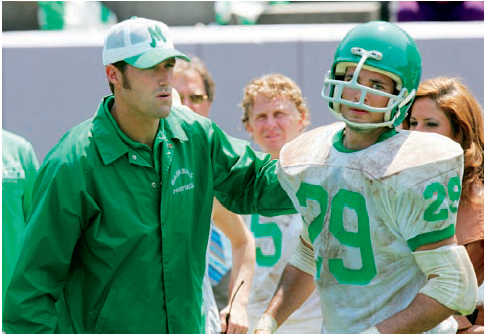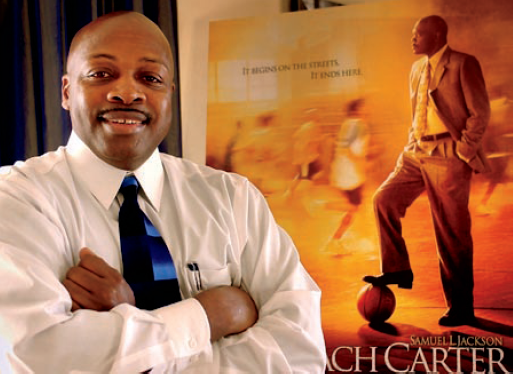

Matthew Fox (left) plays one of the coaches in We Are Marshall, the inspirational true story of a university football team’s rebuilding after a tragic plane crash killed 75 members of the team and coaching staff in 1970.
Reflecting Americans’ love for sports of all kinds, U.S. filmmakers turn repeatedly to sports themes to convey messages much larger than the stories themselves. David J. Firestein is a foreign service officer currently assigned to the Bureau of East Asian and Pacific Affairs, U.S. Department of State. The author of three books and some 130 published articles, Firestein has taught at Moscow State University of International Relations (MGIMO), the University of Texas (Austin), and George Mason University in Fairfax, Virginia.
There are few, if any, countries in the world in which sports—not a sport but sports in general—permeate national life to the degree that they do in the United States. Sports are part of the very fabric of American life, discourse, and lexicon, so much so that it is commonplace to hear prominent national leaders speak about matters of state with reference to such sports metaphors as “throwing up a Hail Mary,” “scoring a slam dunk,” “playing hardball,” and “hitting below the belt.” Indeed, the little black presidential briefcase that holds the codes necessary to launch U.S. nuclear forces is referred to as “the football.”
The centrality of sports in American life is amply reflected in contemporary American cinema. For decades, U.S. moviemakers have successfully mined sports to produce some of the most inspiring, poignant, exciting, and memorable American movies ever made. This tradition started in the first half of the 20th century, but it remains vibrant today. Just in the past few years, Hollywood has produced popular and critically acclaimed films featuring virtually every major sport, from football, basketball, baseball, and hockey, to boxing, horse racing, and even surfing. Since the mid-1970s, four U.S. sports films have won Academy Awards, or Oscars; most recently, Million Dollar Baby (2004), the Clint Eastwood film about a female boxer, won four Oscars, including the one for best picture (an honor the film shares with just two other sports movies). Though American sports movies make use of a common vehicle to explore the fullness of American life and the nuances of human psychology, they tell us many different things about the values that are important to Americans.
American football, always an important subgenre of U.S. sports cinema, has overtaken baseball in recent years as the sport most frequently featured in U.S. films. The last several years have seen the release of a plethora of serious, high-quality football movies that have explored such diverse themes as overcoming adversity (We Are Marshall, 2006); working hard to achieve your dreams (Invincible, 2006); the unrelenting pursuit of excellence (Friday Night Lights, 2004); the power of sports to heal racial/class divides and build communities (Remember the Titans, 2000); and the triumph of an athlete’s innate competitive spirit and innocence over the crass commercialism and cynicism of the U.S. professional sports industry (Any Given Sunday, 1999). As diverse as these themes are, an overarching message about football emerges from these recent films: Football—in its epic scale, over-the-top pomp, gritty attitude, and, yes, hard hitting—is the most complete and vivid sports metaphor for American life itself.
There has been a relative paucity of recent American films about basketball and baseball, the second and third most popular spectator sports in the United States. The two most successful American basketball films of recent years, both based on inspiring true stories, address themes of racial reconciliation (Glory Road, 2006) and teamwork and self-respect (Coach Carter, 2005). Another American basketball classic (Hoop Dreams, 1994), one of the relatively few documentaries in the sports film genre, painted a compelling portrait of inner-city American life and the power—and real-world limitations—of dreams. In their own ways, the two more recent basketball films make the same point: whatever the color of our skin, whatever our rung on the socioeconomic ladder, we can do great things when we commit ourselves to a larger team and a loftier goal. Hoop Dreams tells us that, even so, it’s probably not going to be easy. Meanwhile, the one major American baseball movie of the last few years (The Rookie, 2002), also inspired by a true story, reminds us, in true American fashion, that you’re never too old to reach for your dreams, whatever the odds against realizing them.

Ken Carter, a high school basketball coach, poses in front of the poster for the 2005 film that told the true story of his work.
Samuel L. Jackson played Coach Carter in the movie.
Hollywood has long demonstrated a fascination with boxing. The three major boxing films produced in recent years (Rocky Balboa, 2006; Cinderella Man, 2005; and Million Dollar Baby, 2004) are all classic underdog stories (while Million Dollar Baby explores other, more complex themes, as well). The underdog theme—a perennial favorite of U.S. producers of sports films—also extends to the Olympic hockey rink (Miracle, 2004) and the horse racing track (Seabiscuit, 2003), in which athletes (and, in Seabiscuit, a racehorse) achieve stunning victories in the face of overwhelming odds.
Collectively, these movies say a lot about American values, but they strike a chord with foreign audiences, as well. That’s because these films, at their core, are less about sports than they are about that part of each of us that yearns to take the field, give our all, and live our dreams.



















